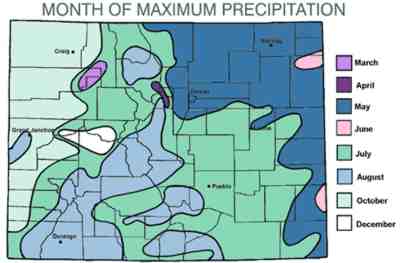Brief by Central Staff
Climate – August 2005 – Colorado Central Magazine
We’re in the wettest time of year in Central Colorado – July and August — when we get about 30% of our annual precipitation in only 17% of our year. “Wettest” is a relative term, since most of our territory is a desert by one standard definition – we get less than 20 inches of precipitation in an average year, and that’s the division between “where normal crops will grow without irrigation” and “where you need a water right unless you like gambling on dryland farming.”
In some of our towns, July is the wettest month, and in the others, it’s August. The farther north you go, the more likely it is to be July.
Climax, for instance, gets 23.1 inches of precipitation in an average year; 2.27 inches come in July and 2.21 in August, and the driest month is June, 1.29 inches. Leadville, about a dozen miles away but 3,000 feet lower, gets 13.24 inches a year, 1.58 in July and 1.36 in August, with June the driest at 0.77 inches.
Go south down the river, and Buena Vista gets 10.31 inches a year with August the wettest month, at 1.89 inches. July is in second place at 1.55 inches, and the driest month is January with 0.34 inches. Salida has a similar pattern; 10.22 inches a year, January (0.27) is driest, and July (1.53) and August (1.58) are the wettest.

So there’s some kind of “climate divide” in the general vicinity of Balltown. We couldn’t find any records for it, but we did find records for other regional locales. Complete statistics for Colorado towns can be found at: http://www.wrcc.dri.edu/summary/climsmco.html
Del Norte (9.85 annual inches) and Alamosa (7.06) follow the same pattern as Salida and Buena Vista. August is the wettest month in both (1.68 in Del Norte and 1.22 in Alamosa), followed by July (1.59 and 1.07), and January is the driest (0.34 and 0.24)
Saguache varies a little from that routine with 8.37 inches of precipitation in an average year. August (1.62) and July (1.51) are the wettest months. However, its driest month is not January (0.27), but February (0.24).
In Gunnison (annual average 10.2 inches), July (1.47) and August (1.48) are basically tied for the wettest. The driest month is November (0.57), and the coldest month is January (average daily minimum -7.2º).
There weren’t any weather records for Fairplay, but Antero Reservoir in South Park (10.1 annual inches) gets the most precipitation in August (2.21) and July (1.93), and January is its driest month (0.19).
Florrisant Fossil Beds is pretty wet (15.17 annual inches) for our part of the world. August (1.9) and July (1.82) provide the most moisture. But there, December (0.25) is the driest month.
The Wet Mountain Valley (14.47 annual inches) is aptly named, at least by comparison to the rest of Central Colorado. Westcliffe’s wettest month is August (2.37) followed closely by July (2.35), and like many other of our towns, it is driest in January (0.46).
Why are July and August our wettest months? According to the Colorado Climate Center, that’s when there’s a lot of warm moist air over the Gulf of Mexico (known as “Hurricane Season” down there). That air often moves north, where it encounters the cool air of our mountains. Cool air can’t hold as much moisture, so the moisture falls to the ground, often in violent afternoon thunderstorms, and frequently as hail.
So, take some rain gear when you head into the hills, and remember who’s likely to win if you encounter a lightning bolt.

